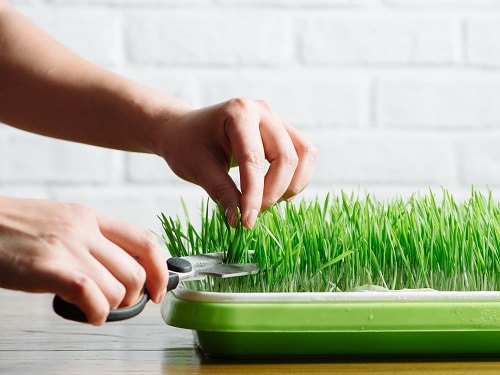Easy to grow and offers tonnes of health benefits, Growing Wheatgrass is something you should definitely try! Here are all the details!
Growing Wheatgrass in a garden or a tray is not too challenging. This short-term specimen needs a very shallow growing medium, and it is a lot safer when grown as an indoor plant. If you are already aware of its many nutritious values and enjoy drinking its juice, then this article is just for you!
Here are the best immunity juices you can grow in pots
Growing Wheatgrass

Approximately 1-2 teaspoons of organic wheatgrass seed is enough to fill a small container and will give you a couple of glasses of juice! The best idea is to keep planting a new batch of seeds every 1-2 weeks!
Steps
- Leave the seeds soaked overnight in clean water.
- Pick a clean and shallow, 10 X 20 inches plastic tray with drainage holes. If necessary, sterilize it with a mild bleach solution before using it and rinse with clean water.
- Fill it a potting mix for about 2-3 inches. Pre-moisten the soil.
- Take out the soaked seeds, sow them in the tray and cover them with a thin layer of soil.
- Water well and keep the tray where it can get bright, indirect sun.
Quick Growing Guide
| Common Name | Wheatgrass, common wheat |
| Scientific Name | Triticum aestivum |
| Germination Time | 20-24 hours |
| Days to Harvest | 7-10 days |
| Light | Initially, indirect light and full sun later |
| Soil | Potting mix |
| Fertilizer | Liquid fertilizer diluted to half of its strength |
| Water | When the topsoil goes a little dry |
| Humidity | Can tolerate dry to moist conditions |
| Temperature | 60-75 degrees Fahrenheit or 15-23 degrees Celsius. |
| Pests | Black grass bugs, fruit flies |
| Diseases | Mold, smut, ergot, stem, or root rust |
Health Benefits of Wheatgrass
Health enthusiasts swear about the countless benefits of this plant and consume it as juice or powdered form. Researchers also agree that Wheatgrass has potential and, when consumed daily as a health tonic, may help treat specific diseases.
Rich in antioxidants, anti-inflammatory, and antibacterial properties, it also contains iron, enzymes, calcium, phytonutrients, vitamins A, C, K, E, and B complex, 17 amino acids, proteins, chlorophyll, magnesium.
Why You Must Add it to Your Diet

1. Metabolism Booster
Drinking Wheatgrass juice can boost your metabolism. It also promotes weight loss as it is low in calories and contains no fat. If you are watching your weight, this can help in reducing the craving bouts.
2. Immunity Builder
This green plant enhances your immune system and once glass of its juice daily can help keep infection and diseases at bay.
3. Cholesterol Reducer
It can help to cut down cholesterol levels, which puts you at a lower risk of developing heart disease.
4. Keeps Blood Pressure in Check
Consuming Wheatgrass can reduce your blood pressure as the chlorophyll molecule is similar to hemoglobin and increases blood cell count. Further, it also helps in normalizing blood pressure, purifies blood, and improves circulation.
5. Helps Arthritis and Diabetes Patients
The Wheatgrass’s anti-inflammatory properties may help ease some of the arthritis symptoms like stiffness, swelling, and pain. It may result in lesser pain, reduced discomfort in walking, and moving.
This plant has also shown the potential to lower down blood sugar levels in diabetes patients mainly because of the compounds that have a similar effect as insulin. It lowers the glycemic index of foods that has a positive impact on sugar levels in the blood.
6. Helps Getting Rid of Toxins, and Gives Energy
The nutrients in the grass help your body get rid of the toxins. Once your body is free of impurities, you feel an increase in energy levels and better overall.
The high levels of enzymes help break down food and absorb nutrients. It also helps to clean down intestines, so you experience fewer abdominal troubles, digestive issues, irritable bowel syndrome, and constipation.


